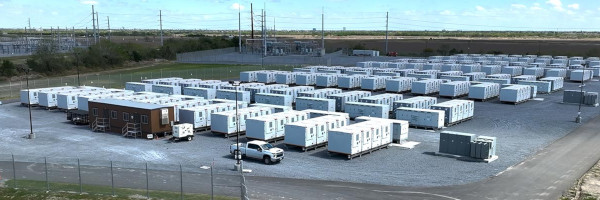Portland General Electric’s 400 MW Battery Energy Storage Project
| Portland General Electric’s 400 MW Battery Energy Storage Project | |
|---|---|

| |
 An aerial photograph of Eolian, L.P.’s Madero & Ignacio battery energy storage facility | |
| Team Organizations | Portland General Electric Eolian |
| Team Leaders | pgecommunications@pgn.com |
| Participating Municipalities | Seaside OR Troutdale OR |
| Status | Launched |
| Document | None |
Description
Portland General Electric (PGE) has launched the largest battery storage project in Oregon, adding 400 MW of non-emitting capacity across two locations to bolster clean energy reliability and support the state’s transition to renewable power. These battery storage facilities, located in Seaside and Troutdale, will provide enough energy to power approximately 260,000 homes for up to four hours during peak demand, directly supporting PGE’s carbon reduction goals. The Seaside facility, developed by Eolian, and the Troutdale facility, owned by NextEra Energy Resources, are anticipated to go online by 2025 and 2024, respectively. This project enhances grid flexibility and resilience, positioning PGE to integrate more renewable sources like wind and solar into its portfolio while reducing greenhouse gas emissions in alignment with Oregon's clean energy targets.
Challenges
The Portland General Electric (PGE) battery storage project faces multiple challenges in implementation and operation. Integrating 400 MW of battery storage into the existing grid requires sophisticated coordination to ensure reliable delivery of stored energy during peak demand or extreme weather. Additionally, maintaining system stability while adding intermittent renewable energy sources like wind and solar increases operational complexity for PGE’s grid operators, who must manage fluctuations and ensure consistent energy supply. The project also entails significant initial investment and logistical challenges, from engineering and construction to long-term maintenance. Further, as the largest standalone battery storage project outside California, it involves navigating regulatory requirements and securing community support to successfully bring Oregon closer to its clean energy goals.
Solutions
To address these challenges, Portland General Electric (PGE) has designed a flexible and resilient battery storage solution centered around two strategically sited, high-capacity facilities in Seaside and Troutdale. By positioning the storage systems near key substations, PGE can rapidly deploy stored energy when demand peaks, reducing reliance on fossil fuels and minimizing the strain on energy markets. Utilizing four-hour duration lithium-ion batteries, the storage facilities ensure reliable energy availability, even when renewable generation from wind and solar fluctuates. Through partnerships with experienced developers Eolian and NextEra Energy Resources, PGE leverages proven technology and operational expertise, facilitating smooth integration into Oregon's grid and enhancing the system’s ability to support state decarbonization targets. This setup provides a scalable model for future clean energy projects and strengthens local resilience with family-wage job opportunities in the green energy sector.
Major Requirements
The Portland General Electric (PGE) battery storage project requires advanced lithium-ion battery technology capable of four-hour energy discharge, a design robust enough to deliver 400 MW of consistent power during peak demand periods. Precise siting of storage facilities at high-demand substations in Seaside and Troutdale is essential to optimize power delivery and support grid stability in the Portland metropolitan area. Additionally, the project depends on the expertise of trusted developers, with Eolian and NextEra Energy Resources providing development and operational insights to meet regulatory, safety, and environmental standards. Long-term maintenance protocols and skilled personnel are also critical to ensure sustained performance and reliability. This large-scale implementation necessitates substantial upfront capital investment, along with community engagement to secure local support and navigate the regulatory landscape, all while aligning with Oregon’s clean energy targets for 2030 and beyond.
Performance Targets
| Key Performance Indicators (KPIs) | Measurement Methods |
|---|---|
|
|
Standards, Replicability, Scalability, and Sustainability
PGE’s 400 MW Battery Storage Project will adhere to essential standards for safety, reliability, environmental responsibility, and grid interoperability. Key standards include IEEE and UL guidelines for connecting energy storage to the grid, managing system performance, and ensuring safe operation, while NFPA 855 and NFPA 70 address fire safety and hazard mitigation for battery installations. ISO standards support sustainable environmental and occupational safety practices, and ANSI/IEC standards help evaluate risks such as thermal runaway in lithium-ion batteries. Finally, EPA, FERC, and NERC guidelines ensure responsible material handling, grid reliability, and regulatory compliance. Collectively, these standards help PGE ensure that the project meets technical, environmental, and safety requirements, supporting Oregon’s clean energy objectives.
Cybersecurity and Privacy
Cybersecurity is a vital aspect of PGE’s 400 MW Battery Storage Project, focusing on safeguarding its digital and physical infrastructure from potential cyber threats. The project will implement a comprehensive strategy that includes risk assessments, robust network security measures such as firewalls and intrusion detection systems, and data encryption for sensitive information. Strict access controls, including multi-factor authentication, will be enforced, along with a detailed incident response plan to address cybersecurity incidents effectively. Additionally, the project will assess the cybersecurity practices of vendors, conduct regular audits and assessments, and comply with industry standards like the NIST Cybersecurity Framework. Ongoing employee training will further foster a security-conscious culture, ensuring the reliable operation of the energy storage system while protecting sensitive data and maintaining public trust.
Impacts
The PGE 400 MW Battery Storage Project is set to deliver substantial impacts by enhancing Oregon's clean energy transition, improving grid reliability, and reducing greenhouse gas emissions through increased integration of renewable energy sources. It will create jobs and stimulate local economic growth during construction and operation, while also stabilizing energy costs and reducing dependence on fossil fuels. The project fosters community engagement and awareness of renewable energy initiatives, positioning PGE as a leader in energy storage technology and serving as a model for future projects. Overall, it represents a significant step toward environmental sustainability and innovation in the energy sector.
Demonstration/Deployment
TBD